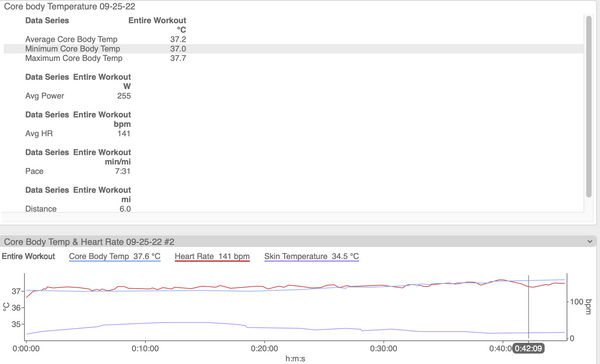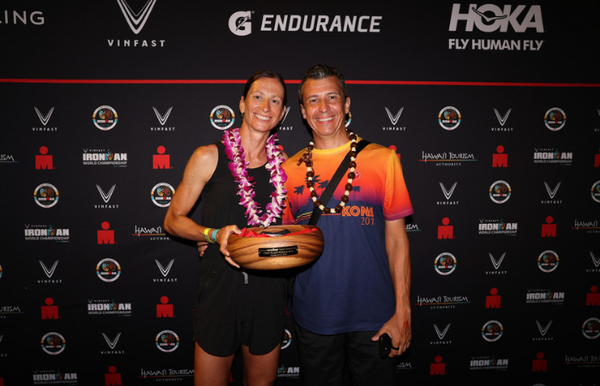CORE for Coaches: A Kona Case Study
In this case study, Jana Richtrova used CORE in training for the 2022 Ironman World Championships, where she won her 40–44 age group. She was coached by Jorge Martinez, head coach at E3 Tri Coaching and owner of the FreeSpeed Lab, who has been using CORE since July 2021. Here, Jorge details Jana’s training with CORE.
This year we used the CORE sensor to help one of our athletes, Jana Richtrova, in her quest to win her age group at the Ironman World Championship in Kona. We live in The Woodlands, Texas, so heat and humidity is something we are very familiar with. Thus, we used the core in a slightly different way beyond just determining her heat training zone and heat adaptation.
In spring, we used CORE to do her heat ramp tests for the bike and run. We also did full metabolic testing (Moxy, spirometry, VO2/VCO2, lactate & sodium/sweat loss.) for both the bike and the run. Thereafter she wore the CORE sensor for the majority of her training sessions both indoors and outdoors. Along the way we noticed that for cycling Ironman race power or run Ironman race heart rate, she was never riding/running close to her heat training zone of 38.1–38.5° C (100.6–101.3° F). However, because she was used to training in the heat, heat adaptation was not necessarily our focus.

Determining race core temps
Through the season, we tracked Jana’s core temperature during bike/run workouts at Ironman race efforts. We knew what sort of power range we wanted her to target on the bike and pace on the run to put her in contention for the win, so that’s what she trained at. We noticed that her core temps differed when she performed well from when she had a rough training day.
But on some days she didn’t train properly for the weather conditions around here (avg. ~33° C/91° F and ~60%+ humidity), and her core temp would tend to show an upward trend and go outside her Ironman zones. This was usually on days she either pushed the power during the bike and/or did not drink enough fluids (plus carbs/sodium). Then, she would struggle some towards the end of the ride or get through the bike “fine” but invariably struggle on a transition run as her core temp would rise quickly outside her run Ironman heat zone.
Fueling and hydration was key
On the days Jana fueled/hydrated/paced well, her power/HR/lactate would stay consistent, she would feel great and run strong off the bike under the same weather conditions. We concluded her cycling Ironman race heat zone was ~37.1–37.4° C (98.8–99.3° F) and for running ~37.3–37.6° C (99.1–99.7° F).
Also, on long runs, we tested staying within this temp range or higher and she executed best in the mentioned range. Thus 37.4° C became our bike upper temp limit and 37.6° C for the run.
We arrived in Kona 16 days before the race, and she did her final long prep session there. Targeting these temperatures zones, she had strong race simulations.
Examining the data
The data below compares one of Jana’s bad training days with her final race preparation on the island. During the September 3 bike workout (105 miles), she reached a normalized power of 188 watts with a heart rate of 151 bpm. During a similar workout on September 23, her normalized power was 199 with a heart rate of only 139. During the bad workout, her core temp reached 37.6° C/99.7° F, and we believe she underhydrated. During the good workout, her core temp reached only 37.4° C/99.3° F, and we believe she was optimally hydrated.
Bad day cycling


Good day cycling


The transition runs on the good and bad days show the results of being dehydrated and pushing too high of a core temp on the bike. On the bad day, her core temp and heart rate quickly climbed, and she needed to show to a 7:55/mile pace (4:55/km). On the good day, her core temp and heart rate stayed where we expected it, and she could maintain a 7:30/mile (4:41/km) pace.
Good day running

Bad day running

Race day
Unfortunately, Jana couldn't wear her CORE sensor on race day as her heart rate chest strap stopped working the day before the race and we only had an arm-based optical HR monitor for her to wear. She didn’t want to wear the CORE sensor taped to her body, as that may have loosened over the day, and she could end up losing it.
But based on her power/HR data, I assume she most likely stayed rather close to her temperature targets. She was 100th off the swim (not her best sport), and moved to 1st off the bike with a 1-minute lead over 2nd place. By mile 16.5 (start of the energy lab) she had built a 12 min lead, so thereafter she slowed down as no one was running fast enough to catch her. She ended up winning by about 10 minutes.
The CORE sensor helped us dial in her power/run heart rate in hot conditions. Most importantly, it helped us dial in her fluid intake – which we knew from the sweat rate test but became obvious for her from the good/bad training days.
In the end, she achieved her goal of winning the Female AG 40-44 & earning her the Ironman World Championship.

